
On commemorative occasions, the City of Toronto remembers those who have given their lives in service to our country. We pay respect to them for helping create and shape the rights and freedoms we enjoy today. In doing so, we also honour the men and women who have served and continue to serve our country in the Canadian Armed Forces.
There are many symbolic elements that pay tribute to those who have fallen, those who have served and those who continue to serve during times of war, conflict, as well as those who help maintain peace.
Our rituals of Remembrance, whether at ceremonies or in virtual commemoration, often include various symbolic elements explained below.
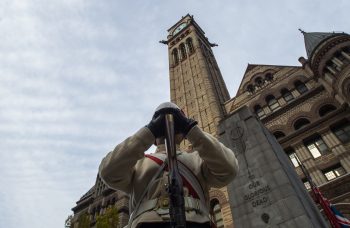
A cenotaph is a monument to people who died in a war, specifically those who are buried elsewhere. Over the past 100 years, Torontonians have gathered at cenotaphs on November 11th and at other times of the year to pay tribute to the fallen.
Thousands of Canadian servicemen and women, some from Toronto, are buried in graves throughout Europe and other locations, or were lost at sea or in battle and their bodies were never recovered. Canada began the repatriation of fallen soldiers and UN peacekeepers in 1970.
During the first Armistice Day ceremony in Toronto (marking the end of the First World War), the City began the tradition of paying tribute to our fallen soldiers at a cenotaph. On November 8, 1920, Toronto City Council voted to erect a temporary cenotaph at the base of what is now the Old City Hall, to observe Armistice Day.
In 1925, a permanent cenotaph was erected at Old City Hall.
Locations of the cenotaphs seen in this video:
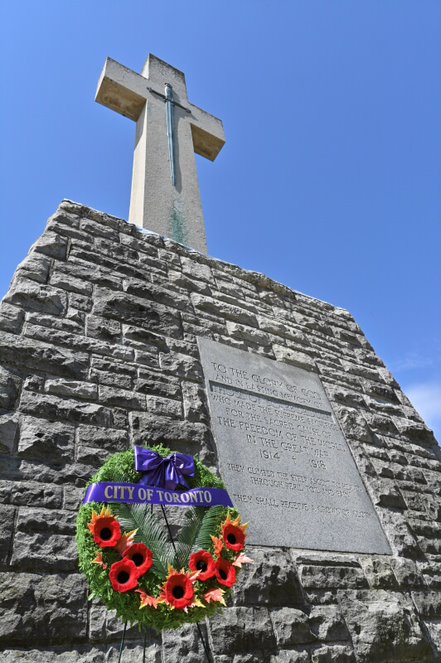
The Scarborough War Memorial is located where Kingston Road and Danforth Avenue meet. This soaring landmark sits within an eye-shaped, 300-metre-long park surrounded by mature hardwood, pine trees and flowering shrubs. Plans to erect a local memorial and the site selection began at a time when war memories were fresh in the minds of residents and when many were still suffering from the impacts of the First World War. The Scarborough War Memorial cenotaph was designed to mark the end of the war.
In the 1920s, Kingston Road and Danforth Avenue met at an abrupt angle, so the intersection was rerouted to its current configuration.
The roads were separated to form the current memorial setting.
On August 30, 1931, before a crowd of 3,000, officials and dignitaries unveiled the Scarborough War Memorial. The inscription reads in part: Their Names Are Hallowed in the Land They Loved.
The limestone used in the memorial is from 400-million-year-old Palaeozoic rock that rests below large areas of southern Ontario. The inset inscription panels are igneous rock found in Canadian Shield. The memorial reflects the geological foundations of southern Ontario and the land to which the fallen soldiers did not return as they were buried where they fell in battlefields abroad.
A concrete cross, adorned with a brass sword, surmounts a stone cairn. While the Memorial was built to honour those lost in the Great War, plaques where later added to acknowledge Canadian participation in the Second World War and Korea.
The War Memorial was unveiled by the Admiral of the Fleet, Lord Jellicoe who commanded the Grand Fleet of the Royal Navy and became First Sea Lord during the war and the Premier of Ontario, the Hon. George S. Henry.
It was the 90th anniversary of the official unveiling and dedication of this monument in 2021.
Other memorials are also located on the City of Toronto’s Public Art Map.
More information on memorials and war cemeteries in Canada and around the world that honour Canadians can be found through Veterans Affairs Canada .
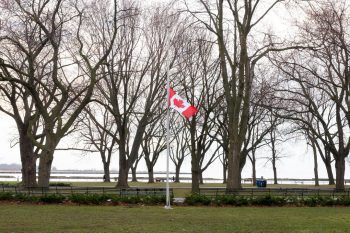
A Canadian Flag that flew at the Canadian National Vimy Ridge Memorial in France during Remembrance Week in 2020 is raised on commemorative occasions at Coronation Park.
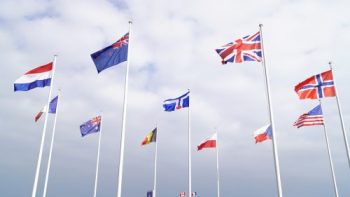
To mark the 75th year since the Normandy invasion by allied forces (D-Day), a City of Toronto Flag was raised at the Juno Beach Centre in France on April 9, 2019, Vimy Ridge Day. This commemorative flag flies at City Hall on Remembrance Day, and on other occasions.
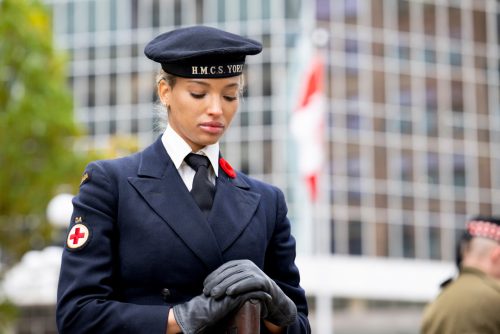
Sentries stand vigil at the four corners of the cenotaph or memorial with heads bowed and rifles reversed (known as reverse arms).
The sentries take their post prior to the commencement of the commemorative service and remain in position until the colours are marched off and they are dismissed.
The vigil sentries often represent different elements of the Canadian Armed Forces such as the Royal Canadian Navy, Army and Royal Canadian Air Force or members of the Armed Forces in historical uniforms from various eras. Sentries may also be Royal Canadian Army, Sea, or Air Cadets or the RCMP.
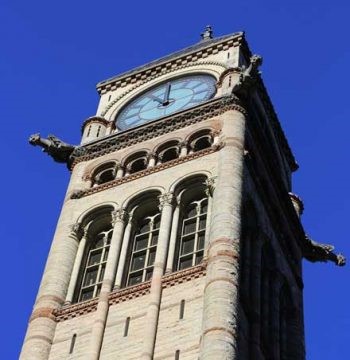
The Old City Hall clock tower bells ring at 11 a.m. to mark the end of the First World War and the armistice that went into effect on the 11th hour of the 11th day of the 11th month. This date is now known as Remembrance Day.
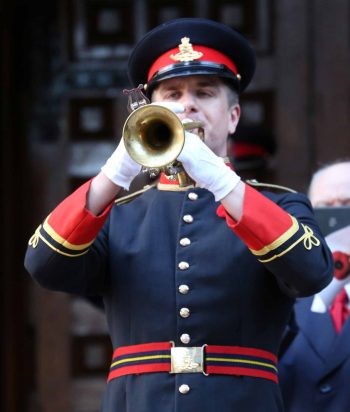
The Last Post is played by a bugler. It symbolizes the end of the day in the military to let soldiers on the battlefield know that fighting was over and that they should return to camp.
Today, in a commemorative service, the playing of The Last Post symbolizes the soldiers’ final call and summons their spirit to the cenotaph.
Playing it at the beginning of the ceremony suggests that the day’s proceedings are outside the norm, as it is a day of commemoration.
The ceremony starts with what is normally at the end of the day and ends with what is normally the start.
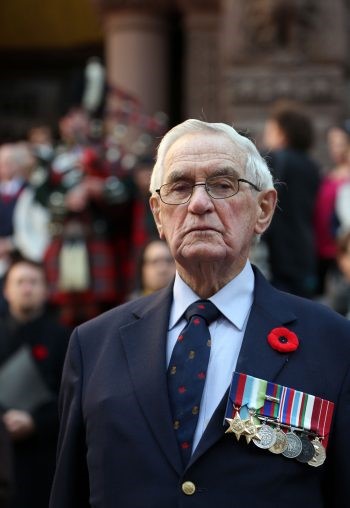
Two Minutes of Silence is the central element of Remembrance Day ceremonies. It is a time to pause and remember the service and sacrifice made by men and women who have given their lives in service to our country.
The Silence originated in 1918 in Cape Town, South Africa, where there was a daily moment of silence, which was initiated by a daily firing of the noon day gun. This action was instituted by the Cape Town Mayor on May 14, 1918. The first minute was a time of thanksgiving for those who had returned alive, the second was to remember the fallen.
In 1919, King George V asked that it be observed throughout the Commonwealth and it has been an important feature of remembrance since then.
In Ontario, the Remembrance Week Act, 2016, encourages the voluntary observance by the people of Ontario to pause and observe two minutes of silence.
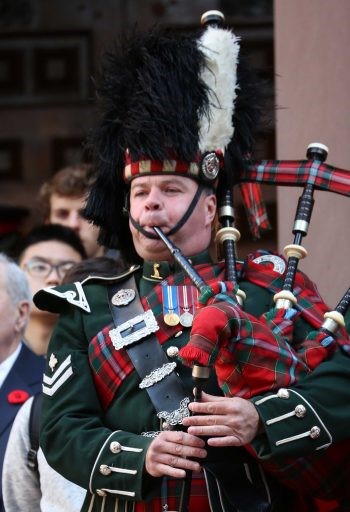
The Lament to the Fallen is played by a piper to honour the fallen.
Flowers of the Forest, a Scottish folk tune commemorating the defeat of the Battle of Flodden in 1513, is often played at a funerals.
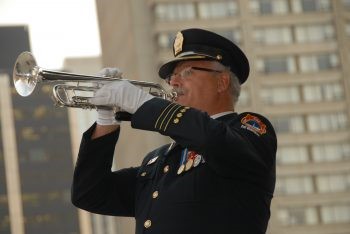
The Rouse is played by a bugler. It is normally the first call sounded in the morning and is used as a wake-up call for the soldiers.
During a Remembrance Day ceremony, it is played to signify the resurrection of the spirit of the fallen at the conclusion of the act of remembrance.
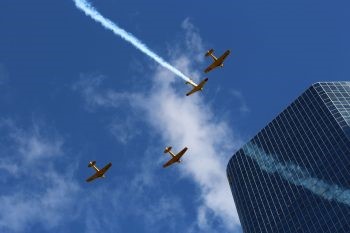
The Remembrance Day fly past is an aerial salute that pays respect to the fallen through “missing man formation”.
The Canadian Harvard aircraft was used to train the thousands of pilots during World War Two. Harvards were used in the last phase of training before a pilot got their wings and moved on the fighters or bombers in operational units. As part of the British Commonwealth Air Training Plan, the Harvards were used in training more than 20,000 pilots throughout the duration of the Second World War.
The Act of Remembrance is read by a veteran to remember their fallen comrades.
“They shall grow not old, as we that are left grow old;
Age shall not weary them, nor the years condemn.
At the going down of the sun and in the morning
We will remember them.”
Response by all: “We will remember them.”
“Ils ne vieilliront pas comme nous,
qui leur avons survécu
Ils ne connaîtront jamais l’outrage
Ni le poids des années.
Quand viendra l’heure du crépuscule
Et celle de l’aurore,
Nous nous souviendrons d’eux.”
Réponse: “Nous nous souviendrons d’eux.”
These four lines are from the famous poem “For the Fallen”, written by British poet Laurence Binyon in 1914, during the First World War. This poem reflected his emotions about the casualties in the Great War. The Act of Remembrance features prominently at Canadian and Commonwealth remembrance commemorations.
The Commitment is often read by a student in the language of their choice. It represents the torch being picked up by the younger generation.
“They were young, as we are young,
They served, giving freely of themselves.
To them, we pledge, amid the winds of time,
To carry their torch and never forget.
We will remember them.”
In unison: “We will remember them.”
“Ils étaient jeunes, jeunes comme nous.
Ils ont servi, donnant généreusement d’eux-mêmes.
Nous leur promettons, en dépit du temps qui passe,
De porter le flambeau et de ne jamais oublier.
Nous nous souviendrons d’eux.”
Tous répondent: “Nous nous souviendrons d’eux.”
In Flanders Fields” is a war poem written during the First World War by Canadian physician Lieutenant-Colonel John McCrae. He wrote it on May 3, 1915, after presiding over the funeral of friend Lieutenant Alexis Helmer, who died in the Second Battle of Ypres. Flanders Fields is a common English name of the World War I battlefields in Belgium and France.
In Flanders fields the poppies blow
Between the crosses, row on row,
That mark our place; and in the sky
The larks, still bravely singing, fly
Scarce heard amid the guns below.
We are the Dead. Short days ago
We lived, felt dawn, saw sunset glow,
Loved and were loved, and now we lie
In Flanders fields.
Take up our quarrel with the foe:
To you from failing hands we throw
The torch; be yours to hold it high.
If ye break faith with us who die
We shall not sleep, though poppies grow
In Flanders fields.
It is read often at Remembrance services in Canada and throughout the Commonwealth.
O Canada is played to start the ceremony. The Royal Anthem, God Save The King, is played at the conclusion as it was often used during the First World War and reminds us of the sacrifice to Crown and country.